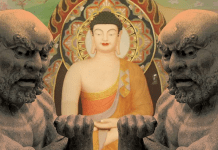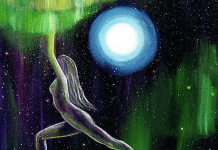 Feast or Famine: Teachings On Mind and Emotions
Feast or Famine: Teachings On Mind and Emotions, by Lee Lozowick, with an introduction and afterword by Regina Sara Ryan
HOHM Press, 978-1-890772-79-6, 219 pp. (incl. afterword, appendix and index), 2008
Feast or Famine is a collection of partial talks and Q&A sessions given by Lee Lozowick to groups of his students. Lee is a spiritual teacher of 35 years, and the ‘spiritual son’ of Yogi Ramsuratkumar. Lozowick himself had minimal involvement with the book, which was the project of one of his students, Regina Sara Ryan. In addition to editing duties, Ryan wrote the Introduction and the Afterword, which includes a selection of Lozowick’s devotional poetry. She also includes a passage from one of Lozowick’s diaries (which he publishes for the use of his students) as an appendix.
The book comprises 13 chapters on the behaviour of mind and emotions, which follow a similar pattern: Lee uses teachings from other spiritual traditions as a starting point for discussion. Lozowick is an eclectic teacher, drawing from Tibetan Buddhism (Chogyam Trungpa, Pema Chodron), Gurdjieff, Sufi Llewellyn Vaughan-Lee, Zen master Seung Soen, Swami Prajnanpad, Arnaud Desjardins, E.J. Gold, Dr. Robert Svoboda, and Carlos Castenada, among dozens of others.
In the introduction, Ryan forewarns readers that Lozowick is an unpredictable teacher; one who presents his information in a convoluted manner and with advice that can be perceived as inconsistent because it is tailored to the individual questioner. This warning proved largely unnecessary. Lozowick’s style is accessible and immediate; he rarely mentions a technical term, and his focus is on immediate and practical utility rather than academic understanding. While his advice may sometimes be inconsistent, it is typically presented within the context of the questioner’s problems, and this minimizes the possibility of misunderstandings. The book, as is often the case with books based on seminars, is easy to read.
Although the book’s style is accessible, there is a downside to its patchwork approach. Lozowick and Ryan do not attempt to present a comprehensive picture or theory of Mind & Emotion, nor do they provide any sort of “system” for an ambitious practitioner to follow. There are many small techniques from different systems integrated into the discourse, but they are presented piecemeal and without much in the way of context.
It is not surprising that Lozowick’s teachings are so eclectic, as his own credentials are unclear: he is cited as the Spiritual Son of Yogi Ramsuratkumar, he runs an Ashram in Arizona, and, he references his over 35 years teaching. But what does it mean to be Ramsuratkumar’s spiritual son? Furthermore, given that Ramsuratkumar’s spiritual approach was ‘Only God’, how does Lozowick translate this motto into a book on mind and emotion? Typically, teachers will either draw upon the authority and collective weight of the tradition they are a part of, or upon the profundity of their own personal realizations.
The Afterword written by Ryan (a longtime student of Lozowick’s), suggests that neither of these is the case. She suggests that Lozowick does not in fact practice what he teaches—which we have just spent almost 200 pages reading—instead relying completely upon devotion and submission to his Guru. This is not entirely a surprise. It is foreshadowed early in the book:
“Ultimately, the taming and training of the mind fall away and are “out-brightened” by the radiance of Yogi Ramsuratkumar’s blessing force. But in the meantime […] a trained mind is necessary”1
I’m not convinced that Lee has much faith in the practices he expounds throughout the book; I’m not sure he thinks that the problems his students come to him with are solvable—excepting, of course, through devotion and surrender to the Guru’s will and the sheer power of Ramsuratkumar’s blessing.
To show us Lozowick’s devotion to his Guru, and provide an example of surrender, Ryan provides us with samples of Lee’s poetry, specifically ones that mention “mind”. Lee’s poetry paints a curious picture. He dissociates the actions of his mind (the “monkey mind”) from his own self and intentions, and asks for Ramsuratkumar to bless him and take away the distractable mind, indicating that while he aspires to a higher or clearer state of mind he is largely unsuccessful in his efforts.
He refers to himself consistently as “heretic”, “bad poet”, “little sinner”—self-effacing terms that he wears like badges, as though this self-deprecation were necessary for his devotional practice. This attitude too is foreshadowed throughout the book. His teaching voice is flavoured with a faintly vicious self-deprecating humour that could charitably be interpreted as humility or an attempt to connect to his audience, were it not for his poetry, which reveals that this is simply how he feels about himself and likely his students too. Thus the motto “Shut the fuck up.” This self-deprecation is closely tied to a more important issue: the question of whether or not he is a reliable or useful teacher.
Regarding reliability, in general Ryan does a good job of providing factual footnotes to Lozowick’s references. In some cases she is either unable or unwilling to provide evidence or context for Lozowick’s claims. For example, on pages 40-41, Lozowick states “It is said that the influence of our heritage goes back seven generations. […] We know nothing about ancestors back that far. And yet, in the chemical structures of our body, literally, not in some kind of mind memory, but in the chemical structure of our cells, there is pretty consistent agreement that we are influenced by seven generations back.” This is utter nonsense. There is no such known mechanism, let alone consistent agreement on it. If he had made a statement about culture, I would certainly agree that the preceding generations have an influence, but he explicitly states that the influence is not mental but chemical. Why seven generations? It is possible that Lozowick had encountered the notion, originating from the Iroquois, that one must consider the consequences of one’s actions upon the (sometimes cited as seven) generations that follow. This is sensible, but has little to do with the chemical structure of cells.
This cavalier attitude toward facts casts doubt upon the rest of Lozowick’s mostly eclectic teachings—if he so distorts comparatively objective information, how does he fare with parables, terminology, practises from other paths? Especially if, as is evident from his personal path, he’s not big on practising them himself? There are two possibilities: the first is that Lozowick misunderstands or reinterprets what he hears to serve his own biases; the second that he does so on purpose as expedient means to further the spiritual progression of his audience. Unfortunately as Lozowick has no way of knowing what expedient means the readers of this book require, the effect either way is misrepresentation and the distortion of fact.
Although on the surface the majority of the book’s teachings appear soundly transmitted, I have little confidence in Lozowick as an authoritative source; if I was interested in a practise mentioned in the book, I would then seek out its original authorship and confirm that Lozowick has presented it accurately.
The ultimate question is: if Lozowick is mostly presenting practices and insights from other spiritual teachers, why read this book over another? There is very little to distinguish Feast or Famine from competing or complementary teachings; it has little of its own to offer. If one is interested specifically in Lee Lozowick and his lineage, then Feast or Famine will prove full of interesting anecdotes and some actionable advice and teachings. Otherwise, one would be better served by seeking out one of the traditions Lozowick draws from and studying its full teachings in context.
- p. 9 [↩]








